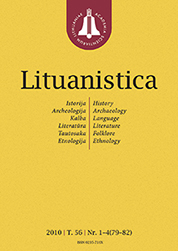LituanisticaWHAT?
 ISSN 0235-716X |
2005 m. Nr. 1 Retorinė norma XIX a. pradžios lietuvių poezijoje
Lithuanian poets of the 19th century most often wrote poetry on certain occasions dictated by their obligations or intentions. A. Klemantas, J. Simkevicius, D. Poðka and S. Valiunas use poetry in order to discuss important social and cultural issues, urging the reader to be active. Such utilitarian treatment of poetry does not imply, however, that the the poetry is of poor quality or that the author’s ambitions are limited. The traditional topic of inspiration, whose origin lies in antiquity, is employed by authors to express the birth of a poem or even the source of the poetry. The 19th century Lithuanian poetry recognizes the authority of the poets and the rhetors of antiquity.
The traditional genres of antiquity maintained many canonical requirements. One of the most popular genres, the literary letter, contains considerable epideictic peculiarities. The literary letter of the period in question may vary in its themes: it can be “friendly”, “praising”, “problematic”, or “exhortative”. Some of the elements it involves may recall the exercises that helped to develop the style of a rhetor. They adhere to the main principles of rhetoric: the style must correspond to and agree with the theme, the sender, and the receiver. The other “anachronistic” genre, which for a long time held a prominent place in Lithuanian literature, is epigram. It was used mostly for practical purposes; aesthetic and didactic objectives serve the function of giving pleasure to the author and to the addressee. Such “poetic exercises” are a sign of a young literature which remains close to the rhetorical norm. |
Numeriai:
2011 - T.57 Nr.1, Nr.2, Nr.3, Nr.4 2010 - T.56 Nr.1-4 2009 - T.55 Nr.1-2, Nr.3-4 2008 - T.54 Nr.1, Nr.2, Nr.3, Nr.4 2007 - T.53 Nr.1, Nr.2, Nr.3, Nr.4 2006 Nr.1, Nr.2, Nr.3, Nr.4 2005 Nr.1, Nr.2, Nr.3, Nr.4 2004 Nr.1, Nr.2, Nr.3, Nr.4 2003 Nr.1, Nr.2, Nr.3, Nr.4 2002 Nr.1, Nr.2, Nr.3, Nr.4 2001 Nr.1, Nr.2, Nr.3, Nr.4 |